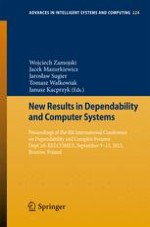2013 | OriginalPaper | Buchkapitel
Critical Infrastructures Safety Assessment Combining Fuzzy Models and Bayesian Belief Network under Uncertainties
verfasst von : Vyacheslav Kharchenko, Eugene Brezhniev, Vladimir Sklyar, Artem Boyarchuk
Erschienen in: New Results in Dependability and Computer Systems
Verlag: Springer International Publishing
Aktivieren Sie unsere intelligente Suche, um passende Fachinhalte oder Patente zu finden.
Wählen Sie Textabschnitte aus um mit Künstlicher Intelligenz passenden Patente zu finden. powered by
Markieren Sie Textabschnitte, um KI-gestützt weitere passende Inhalte zu finden. powered by
The complexity of critical infrastructures (CI) and systems safety assessment calls for the need for integration of different methods that use input data of different qualimetric nature (deterministic, stochastic, linguistic). Application of one specified group of risk methods might lead to loss and/or disregard of a part of safety-related information. Bayesian Belief Network (BBN) and fuzzy logic (FL) represent a basis for development of the hybrid approach to capture all information required for safety assessment of complex dynamic system under uncertainties. Integration of FL-based methods and BBNs allows decreasing the amount of input information (measurements) required for safety assessment when these methods are used independently outside from the proposed integration framework. The processes of CI parameters’ measurement might technically difficult and expensive. Instrumentation layer’s operation might be compromised in emergency situations due to its dependence on power supply. The hybrid methods might be considered as basis for the expert system to help the operator make the decisions. The application of hybrid methods makes operator less dependent on information from instrumentation and control system (I&C). The illustrative example for Nuclear Power Plant (NPP) reactor safety assessment is considered in this chapter.
